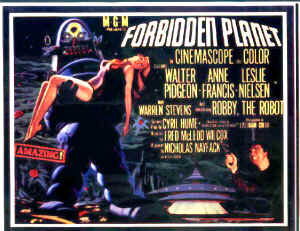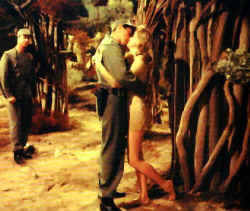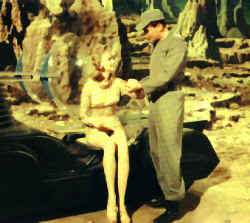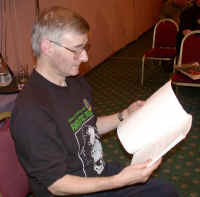Wide Screen Movies Magazine
edited by John
Hayes
Before we go on to the next article, I'd just like to say a few words about its author. I first met Harry Nadler back in the early 1970's when he was running Delta Film Library in Salford - I used to rent 8mm films from him. We soon found that we had a common interest in science fiction and fantasy films, and would chat at length on that most fascinating of subjects. One day, the library closed, and I was not to meet Harry again until 1993, when a mutual interest in 3D brought us back into the same orbit. This time we did not lose touch and we became firm friends, sharing many an outing to cinemas and concerts with our wives, who were often bemused by the fact that we could discuss for hours the wonderful monster movies that we sometimes forced them to watch.
Harry's contributions to fantasy fandom are too numerous to mention. From the legendary fanzine, L'Incroyable Cinema, to the Festival Of Fantastic Films, with Gil Lane-Young and Tony Edwards - now in its 13th year - his love of the genre shone through. In fact, Harry loved everything about film. If it was on celluloid, he collected it. Then VHS, then Laserdisc and lately DVD. He thought it was all wonderful, and his enthusiasm was infectious. Through Harry I became involved with Fantastic Films, and met many interesting people as a result. Ray Harryhausen and Forry Ackerman; writers Jimmy Sangster and Brian Clemens, directors Val Guest and Norman J. Warren and actresses Janette Scott and Janina Faye - two lovely ladies - to name just a few of the people whom they could persuade to attend the Convention. Many guests enjoyed it so much they came back again year after year. Harry made it fun.
When I mentioned to him the idea for this magazine, he embraced it with typical enthusiasm, offered his unqualified help and support, and so we planned it together. I asked him to write me an article, which is the one you will read here. Sadly, two days after he completed it, he died. Harry left this planet on 1st March 2002. "Forbidden Planet - A Cinemascope Sci-Fi Classic" is his last contribution to the genre that he loved most of his life, and in his passing, the movies have lost one of their biggest fans, and he will not be forgotten. He was my friend.
J.H.
By Harry Nadler
 The first "grown-up" novel
I ever read from cover to cover as a child was The War of the Worlds,
which I found in the junior school library. It grabbed my imagination at
exactly the right time and from that moment I was, without realising it,
a science fiction fanatic. My youthful days of the 1950's were also the
birthplace of my love affair with the movies. However at that time the British
censor decided that the films I wanted to see should almost always be labelled
with an "X" certificate, for adult audiences only and so not permissible
entertainment for a space-tripping, monster-hungry 14-year-old.
The first "grown-up" novel
I ever read from cover to cover as a child was The War of the Worlds,
which I found in the junior school library. It grabbed my imagination at
exactly the right time and from that moment I was, without realising it,
a science fiction fanatic. My youthful days of the 1950's were also the
birthplace of my love affair with the movies. However at that time the British
censor decided that the films I wanted to see should almost always be labelled
with an "X" certificate, for adult audiences only and so not permissible
entertainment for a space-tripping, monster-hungry 14-year-old.
My regular search of the evening newspaper's cinema section in 1956 revealed very few new movies that I could get past the cinema staff to see. I looked so damn young for my age! Sunday programming in those distant days was the treasure-trove area for re-release films and I could often catch up with titles like Superman and the Mole Men, Invaders From Mars, Tobor the Great, The Lost Continent, Flight to Mars and The Man From Planet X, as they all had the more accessible "A" certificates. But then came Forbidden Planet, which was not only a "U" certificate but was also in colour AND CinemaScope. This sounded like it was going to be an EVENT!
Set in the year of 2257, interplanetary United Planets' Cruiser C57D reaches its destination, the planet Altair IV, with the prime objective of rescuing the crew of an earlier mission that had crashed on the barren world. The ship's crew, headed by Commander John J. Adams (Leslie Nielsen) discover that there is only one survivor still alive from the earlier expedition, Dr. Edward Morbius (Walter Pidgeon). Morbius has a beautiful daughter, Altaira (Anne Francis) who was born after the crash.
 |
|
Leslie Nielsen, Jack Kelly and Anne Francis |
The story also involves a wonderful robot, Robby, one of the great screen robots of all time and now an icon of science fiction cinema. Morbius had been able to build the robot after having his mind "boosted" by the amazing machines of the plant's original, but now long extinct inhabitants, The Krell. Commander Adams and his crew find themselves pitted against an invisible monster with unstoppable strength that roams the planet and almost brings them to disaster. The rest of the main cast comprises Warren Stevens (Lt. 'Doc' Ostrow), Jack Kelly (Lt. Jerry Farman), Richard Anderson (Chief Engineer Quinn) and Earl Holliman (Cook). The movie's writers cleverly used William Shakespeare's The Tempest for the plot, replacing Shakespeare's sailboat with a spaceship and the remote island of the original with a remote and distant planet. Shakespeare's characters Prospero, Miranda and Ariel are the new residents of Altair IV in the guise of Morbius, Altaira and Robby.
One of thirteen pictures produced in CinemaScope during 1956 by MGM, Forbidden Planet was the first film to be set entirely off-world. Not one section of the story takes place on the planet Earth and that of course meant that every scene had to have specially designed and constructed set, props and costumes. Art direction on the movie was in the extremely capable hands of Cedric Gibbons and Arthur Lonergan. Gibbons is without doubt the most prolific art director Hollywood ever saw. He was supervising art director at MGM for a period of 32 years, notching up the remarkable total of 1,500 movies, with direct charge of 150 of them. During this long career he was also the man responsible for designing the Academy Award "Oscar" and was himself nominated 37 times - collecting his own statuette on 11 occasions! Forbidden Planet producer Nicholas Nayfack (who was also the producer of Robby's second outing, The Invisible Boy), must have felt very comfortable that the look of the picture was in very safe hands. This was Arthur Lonergan's first science fiction picture, although after Forbidden Planet he did art direction on the television Boris Karloff Thriller series and in 1964 worked on Robinson Crusoe On Mars.
 |
|
Jack Kelly compliments Anne Francis |
As neither of the two art directors credited on the film had any previous experience with a science fiction subject, the two production designers, who were uncredited, were most likely to have been the men responsible for the real look of the movie. Irving Block, who also wrote the screenplay for the film along with Alan Adler, had been involved with the genre from 1950 when he worked as a matte painter on Rocketship XM. His career involved him in special effects, writing and producing and other miscellaneous crew jobs on more than fifteen sci-fi and horror films from 1950 to 1959. These included Flight to Mars (1951), Unknown World (1951), World Without End (1956), Kronos (1957), The Invisible Boy (1957) and the British made Behemoth the Sea Monster (1959). So Irving Block's involvement with science fiction must have been an important asset to the film. His co-production designer was Mentor C. Huebner, a very talented artist who did illustration and storyboard work on movies until as recently as 1997. Mentor's credits include Dracula (1992), Dune (1984), Blade Runner (1982), The Thing (1982), Flash Gordon (1980), King Kong (1976) and The Time Machine for George Pal in 1960.
Veteran cinematographer George J. Folsey handled the CinemaScope photography on this completely studio enclosed shoot. George had a long career with MGM and had photographed many of the classic musicals including Meet Me In St. Louis (1944), The Harvey Girls (1946), 'Till The Clouds Roll By (1947), Take Me Out To The Ball Game (1949) Million Dollar Mermaid (1952) and Seven Brides For Seven Brothers (1954). Over his long career from 1919 (His Bridal Night) to 1976 ( new sequences for That's Entertainment Part II) George worked on over 150 movies, but Forbidden Planet was only his second science fiction film in over 30 years. The first was M.A.R.S. (1922) which was unusual for its time in that it was shot in a three-dimensional process, released after its 1922 premiere engagements under the title Radio-Mania in 1923.
Director Fred McLeod Wilcox was a nephew of MGM president Louis B. Mayer and had just nine feature films to his credit when MGM assigned him to what was quite an expensive production at the time, with a budget of just under two million dollars. Forbidden Planet is his only science fiction movie, but his pacing and handling of the actors is excellent. The static sets in which he had to work to tell his story must have been a major drawback to a director more used to outdoor location shooting, but his design team gave McLeod great background visuals in which to present his story.
The amazing robot, Robby, was built in the MGM prop department and credit for his design goes to an MGM art director, Robert Kinoshita, who pushed plastics fabrication and robot design techniques into the future. The robot cost MGM $125,000 to construct. Veteran western actor Frankie Darrow was credited as the guiding force in bringing Robby to life, and it was he who performed inside the robot (see the following article, though). The voice of Robby belonged to Marvin Miller who later worked on a number of US television shows. At the time of my first viewing of the movie - and in fact for a great many years after that - I really thought that Robby was a fully-functioning mechanical creation, and had no idea that there was an actor inside the wonderful machine. Since his original outings in Forbidden Planet and The Invisible Boy, Robby surfaced again in many television shows including Lost In Space, The Thin Man, The Addams Family, Twilight Zone, Columbo, The Love Boat and Mork And Mindy, to name just a few.
Forbidden Planet, with its budget of $1.9 million, was a commercial success on its original release at a time when many of the studios had jumped on to the science fiction bandwagon. The previous year had seen a number of very successful productions in the genre, including George Pal's Conquest Of Space and two Ray Harryhausen effects pictures, The Beast From 20,000 Fathoms and It Came From Beneath The Sea. In Britain the Quatermass Xperiment had performed extremely well for Hammer Films - launching them into an ongoing specialist field of production. Forbidden Planet was released on the heels of a number of black and white science fiction films. Universal's continuing Black Lagoon series entry, The Creature Walks Among Us, was followed by Earth vs The Flying Saucers, from Ray Harryhausen. Roger Corman's The Day The World Ended and Don Siegal's amazing Invasion Of The Body Snatchers were both produced in the Regalscope* process, but the grandeur of colour and CinemaScope certainly made Forbidden Planet an "event" release. It was a dazzling visual experience in its day, and has the quality production values that make it timeless for modern viewers. To see Robby and the gang on a big screen in a theatre environment is a fantastic joy not to be missed if the opportunity ever comes round again.
*Regalscope was a Fox-owned trademark, used for Fox's"B" film division, Regal Films Incorporated. Regalscope was, in fact, just CinemaScope in B&W and mono optical sound.
J.H
